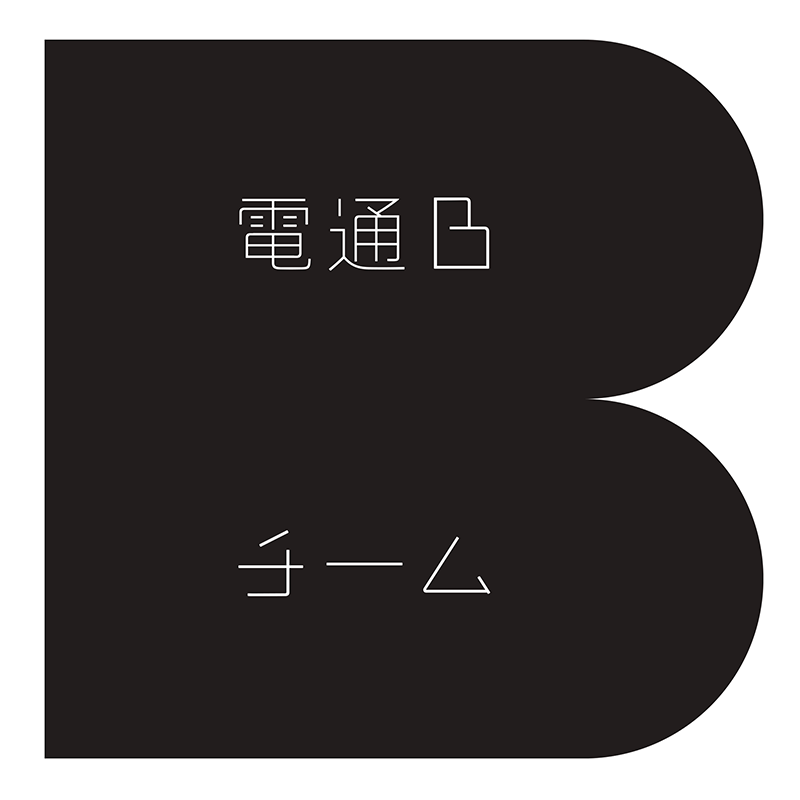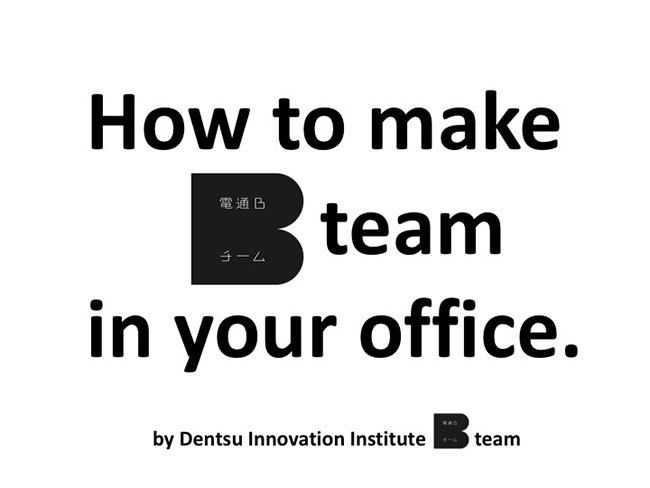Note: This website was automatically translated, so some terms or nuances may not be completely accurate.
Regarding Dentsu Inc. Team B, I'll finally explain it properly.

Hidetoshi Kurashige
Creative Project Base Co., Ltd.
The Dentsu Inc. B Team is an "alternative approach" team comprised of Dentsu Inc. employees who possess top-tier "B-side" skills in various fields. They tackle diverse challenges and stagnation within companies and organizations that cannot be overcome using conventional "A-side" methods, solving them with unique B-side approaches. Team leader Mr. Kurashiro reveals the full picture of this enigmatic team.
What does the "B" in B Team stand for?
Is your company or project performing at its peak? If you're feeling stuck, what methods are you considering to explore different approaches?
I'm Kuranari, the one who launched the somewhat mysterious 'DENTSU SOKEN INC. B Team' three and a half years ago. Last October, with an organizational restructuring, we were renamed 'Dentsu B Team,' making us even more enigmatic.

This B Team. Why "B"? There are various theories, but simply put, it's the "B" in "not A, but B." Plan B to Plan A. Approach B to the conventional approach. In other words, it signifies "alternative." We're a team that experiments with and provides methods different from the past, every day.
With that understanding, I'll go ahead and include the URL below. I'd be delighted if you could take a quick look.
In this series, we'll share excerpts from over 30 processes we've developed with great care—processes that will help those struggling with "I can't create anything new!"
Part 1 covers the origins of Team B and "How to Build a Team B."
It all started with a gathering of eight people on a sofa.
July 2014. Eight employees gathered on the window-side sofa on the 29th floor of Dentsu Inc. headquarters building. What they shared was that beyond their company work in advertising, they each had some personal side to them. If their main job was Side A, these were employees with a Side B.
World-renowned DJ
Novelist
Skiers
Former Editor
Product Designer
Peace activist
Sociologist
Foreign-born individual educated in 6 countries
The purpose of gathering was to drink tea (this is important) and to share information each had gained from their private side activities. We connected existing knowledge across different fields through casual conversation to create concepts. It was an experiment in "creating a think tank with zero research."
This marked the start of Team B, but its birth was driven by growing client demand: "We want help fostering innovation, not just advertising production." At the time, DENTSU SOKEN INC. focused primarily on media and marketing research. The idea was to add a think tank team dedicated to innovation.
We could have issued a company press release announcing, "DENTSU SOKEN INC. Team B is formed!" at this point. But the advertising industry tends to create labs and distribute press releases for every little thing. We decided to skip that and start quietly. Official, yet underground. That's more exciting, right?
Potential Gathering: Collecting Promising Information
After confirming the success of our initial cross-disciplinary information exchange meeting, we began reaching out to more specialists at Dentsu Inc. with their own "B-side" expertise, gradually expanding our team.
Fashion, AI, agriculture, architecture, food, health, makeup, hacking, electronics, finance, traditional crafts, photography, diversity, gaming, education, future forecasting, manga, media art, extreme sports, fishing, festivals, social media, craft beer, handmade goods, rakugo, street culture, molecular gastronomy, and so on and so forth. One person per genre. We now exceed 40 members.
Every month, this group gathers and shares information. We focus on finding information with potential, thinking "This could inspire everyone" or "Could this be applied to other genres?" That's why we call these regular meetings "Potential Gathering." After continuing this for three and a half years, by January 2018, we had amassed an archive of over 2,000 pieces of information from more than 50 genres.
To share a few anecdotes,
- Our team's guiding principle is "CURIOSITY FIRST." Curiosity comes first. When gathering information, having an antenna for curiosity is paramount.
- We prioritize "firsthand information" experienced by members themselves and "information that can't be found through search" (otherwise, it can't inspire others).
- Members hold the title "Special Researcher." For example, since I'm always gathering concepts, I'm the "Special Researcher in Charge of Concepts."

Why does Team B gather information? Because information is an indispensable element in innovation. As James W. Young said, "Ideas are new combinations of existing elements," or as Schumpeter stated, "Innovation is the new combination of different information." I needn't elaborate further, but just to be clear.
To create something new and different, Team B gathers information that's different from others, using methods that are different from others. It's an alternative information gathering method that's fun, emphasizes individuality, constantly stimulates intellectual curiosity, and is incredibly fast.
The recipe for concepts is "information" and "casual conversation."
Once we gather information, it's time to cook it into a concept.
We notice—or create—shared values: how people want to live, what they wish existed. What Team B aims to provide is support for this "shift toward new values." To achieve this, we must transform the gathered information into concepts.

Now, regarding how we create these concepts: once we have interesting members and the diverse information everyone has gathered, all that's needed is casual conversation and a little facilitation. From this, various concepts emerge. Even if it's not a concept, we actively stockpile anything born from these chats—new ideas, new methodologies, projects we wish existed.
"Analog"
"Underdog Tag"
"BUZZ Surfing Theory"
"Serendipity Legacy"
"Gap Ocean" etc.
The concepts Team B has developed can be glimpsed in their Forbes series.
https://forbesjapan.com/author/detail/287/
However, that doesn't mean anything goes. There are things we absolutely refuse to do when creating concepts. One is categorizing people by attributes and labeling them as "Generation XX." It might be standard practice in advertising, but we refuse to lump diverse individuals into a single label.
Another is blindly adopting ideas and methods imported directly from overseas, especially the US. If we only create "Japanese versions of XX," we'll end up with something identical to or inferior to what exists abroad. If we're talking about "innovation," shouldn't we aim to create original concepts and pursue our own unique evolution?
That's how Team B was born, from all these counter-arguments.
Two things the B Team does with the concepts we create.
Once the concept is created, the next step is implementation. The B Team does two things.
One is assisting other companies' projects. This isn't limited to corporations; it includes national and local governments, startups, and NPOs.
When we receive requests like, "We want to innovate but are stuck," or "We want to drive change but can't seem to make it happen," we select and provide a specific "process for generating and executing new ideas" from our stockpile of concepts. It's akin to a "prescription" for the project.
Team B has developed over 20 such new processes. Examples include:

"10-Genre Simultaneous Brainstorming"
"Prototype for One"
"Short Short Idea Generation Method"
"Magic Word Cards"
"4-Dimensional Open Innovation"
"Kaizen the Mottainai"
"Process Makeover"
"Punovation"
"Information Sensory Transformation"
"Inclusive Marketing"
"B-Side Research"
"Adjacent Domain Research"
"Sympathy Networking"
"Creating a B-Team"
Another is executing B Team original projects—initiatives we start even when no one asks us to. For example, "INDUSTRIAL JP" ( http://idstr.jp ), which supports small factories through music and video and won last year's ADC Grand Prix, originated with the B Team. ※Dentsu Inc. News article link
Also, the "Active Learning: How About This? Research Institute" ( http://www.konnano-dodaro.jp ), born from a desire to make education more engaging, is a spin-off from Team B. ※Dentsu Inc. News article link
Many more projects are currently underway or in preparation. We look forward to sharing them with the world.
Let's create a B Team! Our mentors are Miyamoto Musashi and The Beatles.
Finally, I'd like to share one example from Team B's "process" right away. It's a proposal: Why not create a "Team B" within your organization too?
We work in advertising—an industry where "mass information gathers to create large-scale campaigns" (Side A). Yet change always starts small (Side B). The role of Dentsu Inc.'s internal B Team is to create something new through this A × B approach. We want you to apply this to your own organization.
While completely destroying something and building anew from scratch is difficult, it should be possible to keep the main stream intact and run a separate, smaller "other team" with a different mission. After forming the B Team, I learned this approach is called "dual-track management." Indeed, Miyamoto Musashi's dual-sword style involved two swords: large and small.
Another example is The Beatles. When releasing singles, they reportedly aimed for hits on the A-side (yes, we're talking about records) while experimenting on the B-side (though opinions vary). How about dividing functions between front and back in your work too, conducting small experiments behind the scenes?
The know-how for creating a B team is compiled in "How to Make a B Team in Your Office." We've already sent this how-to file to overseas branches belonging to Dentsu Aegis Network, and some branches have already formed B teams. If you're interested, please inquire. Actually, I've already written about a third of it here.

Starting next time, we'll introduce several real-world examples of processes created by B Teams.
Even if small, I look forward to nurturing the seeds of change together with you all. May our experiments prove useful to someone we meet along the way.
Was this article helpful?
Newsletter registration is here
We select and publish important news every day
For inquiries about this article
Author

Hidetoshi Kurashige
Creative Project Base Co., Ltd.
Representative Director/Creative Project Director
Joined Dentsu Inc. in 2000 and was assigned to the Creative Bureau. Since then, expanded and applied advertising skills to lead diverse projects across genres, including collaborations with corporate new business divisions, overall production of APEC JAPAN 2010 and the Tokyo Motor Show 2011, and the 400th anniversary project for Arita ware in Saga Prefecture. Launched Dentsu B Team in 2014 with employees possessing personal B-sides. In 2015, he established the Active Learning "How About This?" Research Institute. On July 1, 2020, he founded Creative Project Base Co., Ltd.